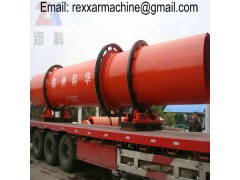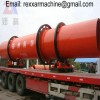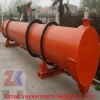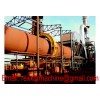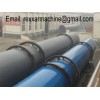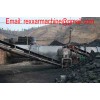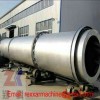Rotary dryer is made up of a large, rotating cylindrical tube, usually supported by concrete columns or steel beams. The rotary dryer slopes slightly so that the discharge end is lower than the material feed end in order to convey the material through rotary dryer under gravity. Material to be dried enters the dryer, and as rotary dryer rotates, the material is lifted up by a series of internal fins lining the inner wall of the dryer. When the material gets high enough to roll back off the fins, it falls back down to the bottom of the dryer, passing through the hot gas stream as it falls.
This gas stream can either be moving toward the discharge end from the feed end (known as co-current flow), or toward the feed end from the discharge end (known as counter-current flow). The gas stream can be made up of a mixture of air and combustion gases from a burner, in which case the dryer is called a direct heated dryer. Rotary dryer is suitable to dry metallic and nonmetallic mineral, clay in cement industrial and coal slime in coal mine etc.
Rotary dryer can be widely used to dry sludge, sand, coal, gypsum, sawdust, mineral slag, sludge, chicken manure, and it is simple to operate.

